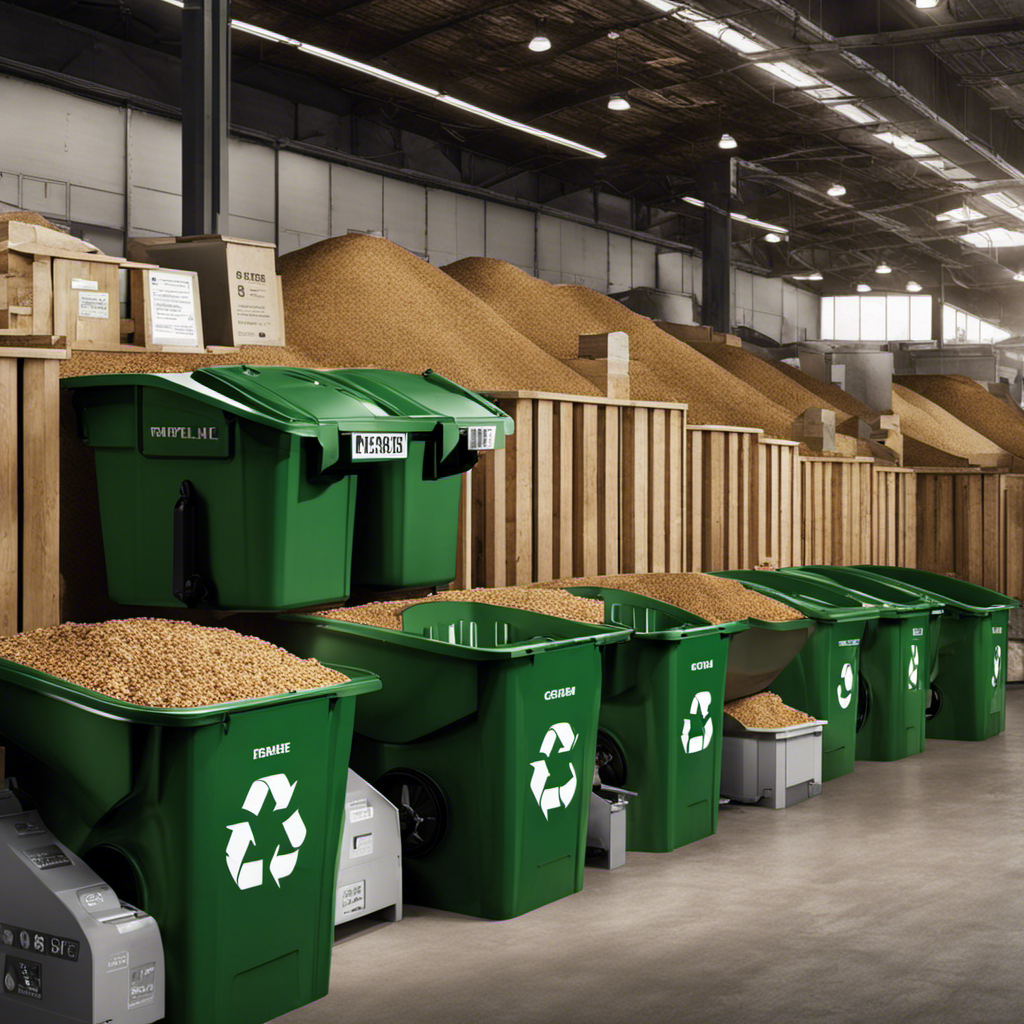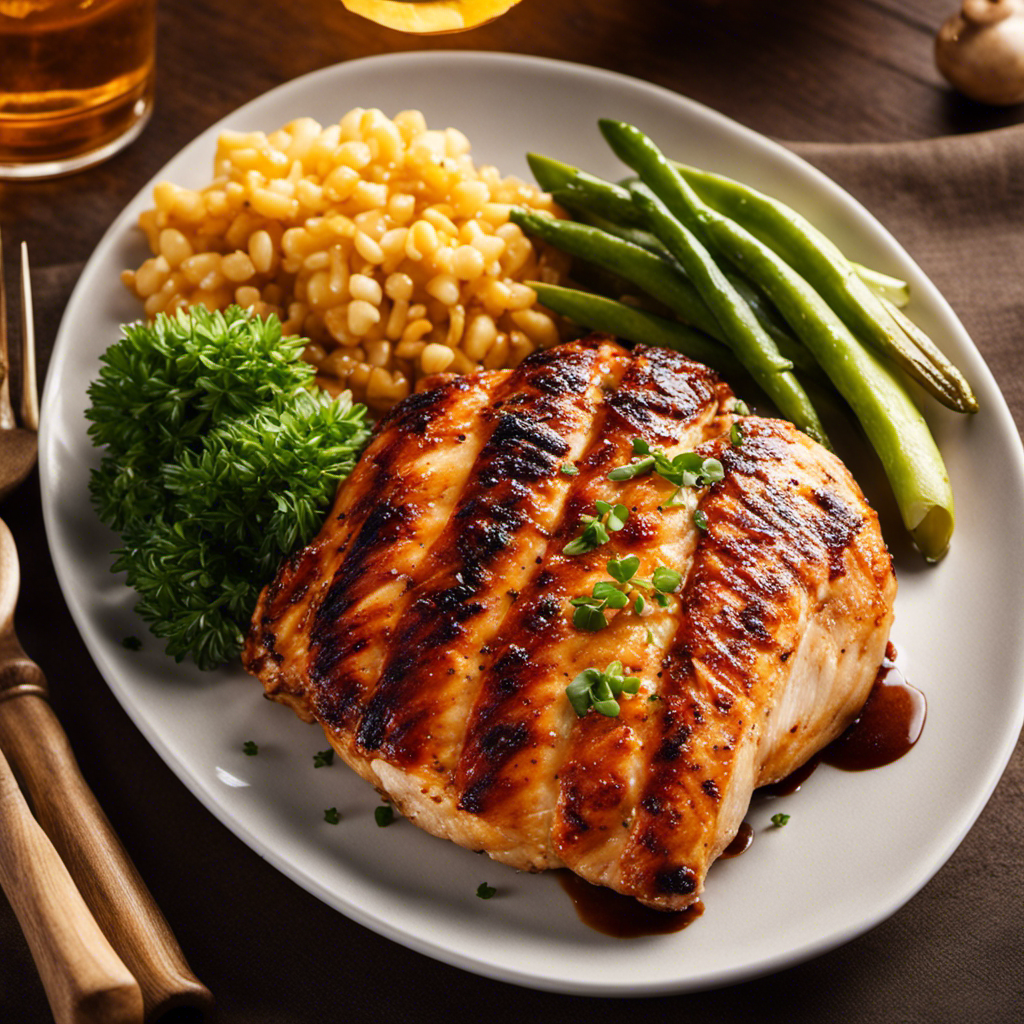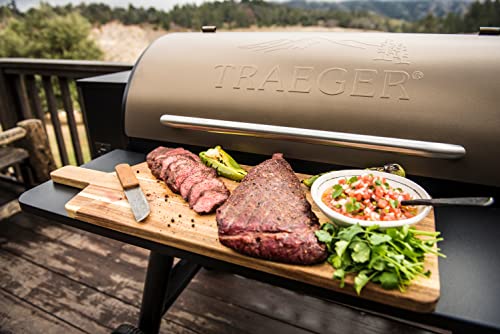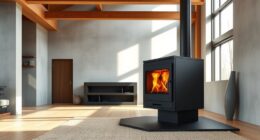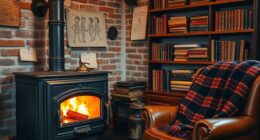Have you thought about the possibilities of converting your wood stove into a pellet stove?
The idea of transforming an old, inefficient wood-burning setup into a modern, convenient pellet-burning system is one that piques curiosity and offers numerous advantages.
The process may seem daunting at first, but the benefits are certainly worth exploring.
From increased heating efficiency to reduced maintenance, the conversion to a pellet stove brings with it a range of compelling reasons to consider making the switch.
Key Takeaways
- Converting a wood stove to a pellet stove offers cost-effective and environmentally friendly heating.
- Pellet stoves provide increased fuel efficiency, reducing emissions and environmental impact.
- Proper storage, handling, and maintenance of pellets are crucial for optimal performance and safety.
- Professional installation and regular maintenance are recommended for the conversion process to ensure efficient burning and longevity of the pellet stove.
Benefits of Pellet Stoves
Converting to pellet stoves offers homeowners a more cost-effective and environmentally friendly heating solution compared to traditional firewood.
Pellet stoves are designed to be more efficient, resulting in cost savings and greater heating efficiency. Wood pellets are cleaner and easier to handle than large logs, requiring less maintenance and producing less ash. This not only saves time and effort but also contributes to a cleaner indoor environment.
Additionally, pellet stoves are more environmentally friendly, producing less smoke and harmful emissions compared to traditional firewood. The reduced environmental impact and cleaner burning make pellet stoves an attractive option for those seeking to minimize their carbon footprint.
Furthermore, pellets take up less space, are more economical, and offer greater convenience compared to traditional firewood. These factors make converting to pellet stoves a practical and beneficial choice for homeowners looking for a more sustainable and efficient heating solution.
Environmental Impact
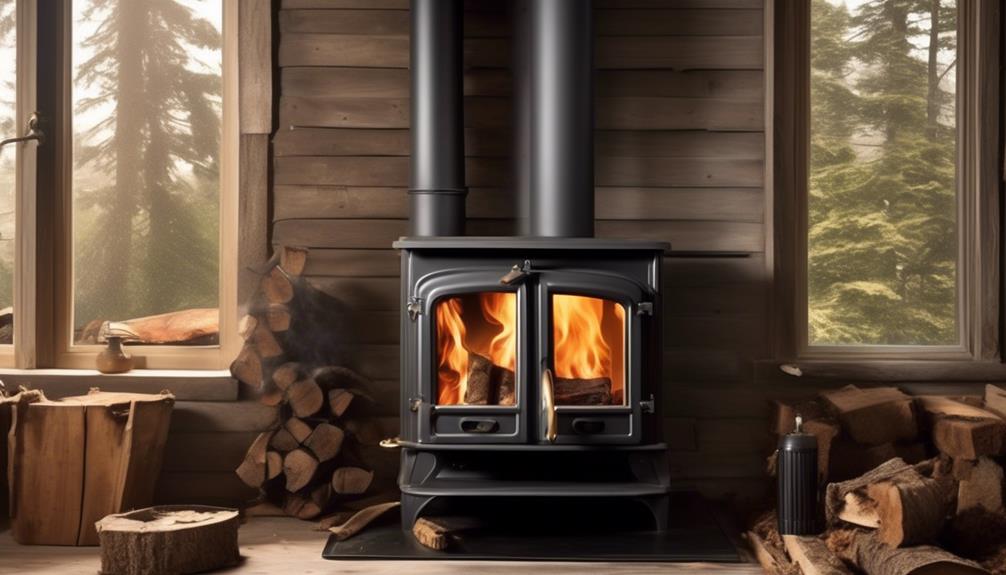
Switching from a wood stove to a pellet stove can significantly reduce harmful emissions and promote cleaner burning.
This change can also lead to higher combustion efficiency and a lighter environmental footprint.
As a renewable energy source, wood pellets offer a more sustainable and environmentally friendly alternative to traditional firewood.
Emissions Comparison
When comparing emissions, pellet stoves demonstrate a significant reduction in smoke and harmful emissions as compared to traditional wood stoves. This is due to their cleaner burning process, which releases less smoke and harmful emissions, contributing to a lighter environmental footprint.
The enhanced efficiency of pellet stoves, often exceeding 80%, leads to lower fuel consumption and potentially reduced heating bills. Additionally, pellets are made from renewable materials, reducing the dependency on finite wood resources.
Converting to pellet burners helps reduce overall environmental impact by decreasing emissions and reliance on non-renewable resources. Furthermore, the switch to pellet stoves can significantly reduce the carbon footprint associated with home heating, contributing to a greener and more sustainable lifestyle.
Making the decision to convert your wood stove to a pellet stove can lead to a substantial improvement in emissions and environmental impact.
Fuel Efficiency
Burning wood pellets in a pellet stove yields greater fuel efficiency and reduces environmental impact compared to using traditional firewood.
Wood pellets burn more efficiently, producing less smoke and ash, leading to a cleaner and more environmentally friendly heating option. This not only results in cost savings but also reduces environmental impact due to the higher heating efficiency of pellets.
Additionally, the switch to a pellet stove helps to lower emissions and requires less maintenance, thus contributing to environmental sustainability.
Converting to pellet burners enhances environmental sustainability by utilizing a renewable energy source and decreasing reliance on traditional firewood. This transition to pellets not only increases fuel efficiency but also significantly reduces the environmental impact of heating, making it a more sustainable and eco-friendly choice.
Conversion Process
Now, let’s take a closer look at the conversion process for turning a wood stove into a pellet powerhouse.
We’ll cover the equipment needed, the installation steps, and the maintenance requirements for your newly converted pellet stove.
This information will help you understand the necessary steps and considerations involved in this conversion.
Equipment Needed
We recommend considering the purchase of a pellet insert, such as the Energex Prometheus insert, to effectively convert the wood stove into a pellet stove. When converting a wood stove to a pellet stove, the following equipment is needed:
- Pellet insert: Invest in a high-quality pellet insert, like the Energex Prometheus insert, for a seamless conversion process.
- Metal grate: Ensure the availability of a metal grate to facilitate air circulation and provide support within the pellet insert.
- Conversion kit: If opting for a conversion kit, verify its compatibility with the specific wood stove model.
- Steel netting and wire: Acquire steel netting and pliable steel wire for constructing a pellet basket to burn wood pellets in the wood stove.
- Pellets: Purchase wood pellets, the primary fuel source for the converted pellet stove.
Installation Steps
Upon consulting a qualified technician and securing the necessary supplies and parts, the next step in the wood stove to pellet stove conversion process is to proceed with the installation steps. The installation involves several crucial steps to ensure a safe and successful conversion. Here is a breakdown of the installation process:
| Installation Steps | Description |
|---|---|
| Prepare the Stove Area | Clear the area around the wood stove, ensuring there are no flammable materials nearby. |
| Remove Old Components | Carefully dismantle and remove the old wood stove components, including the firebox and flue. |
| Install Pellet Stove | Assemble and install the new pellet stove according to the manufacturer’s guidelines and local codes. |
Following these steps, it is essential to have a professional technician perform the installation to guarantee compliance with safety standards and optimal functionality.
Maintenance Requirements
When maintaining the converted pellet stove, it’s crucial to regularly clean the ash and soot buildup to ensure optimal performance and safety. To effectively maintain the wood stove after conversion, follow these key steps:
- Clean the ash and soot buildup from the burn pot, heat exchanger, and venting system regularly.
- Use a vacuum designed for ash removal to prevent the release of fine particles into the air.
- Inspect gaskets, seals, and electrical components for wear and tear, and replace them as needed to prevent air leaks and ensure safe operation.
Regular maintenance ensures the efficient and safe operation of your converted pellet stove, prolonging its lifespan and maximizing its performance.
Choosing the Right Pellet Stove
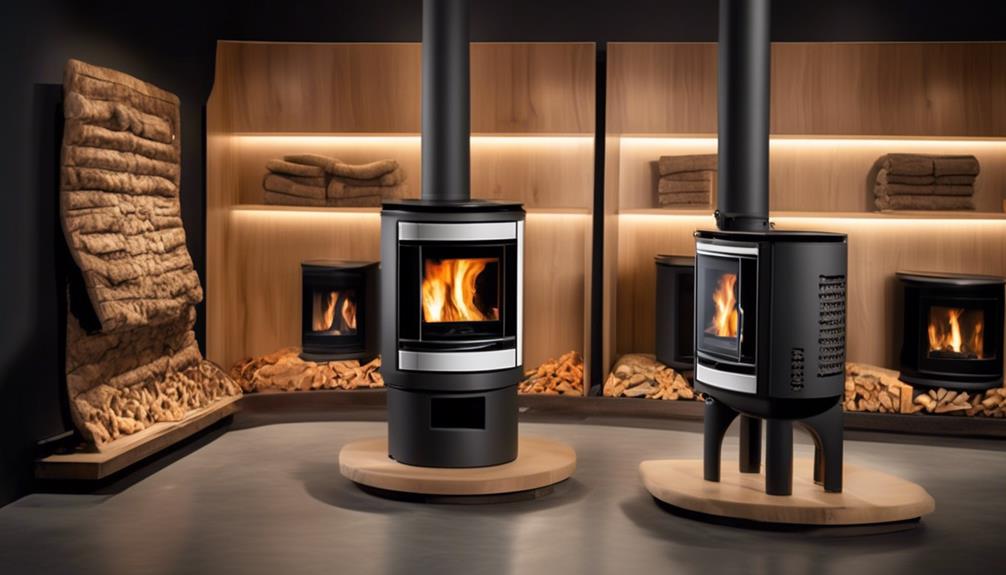
When considering the purchase of a pellet stove, there are several factors that should be carefully evaluated.
First and foremost, it is essential to evaluate the heating capacity of the pellet stove. This means considering the size of the area you intend to heat and ensuring that the chosen pellet stove can effectively warm the space.
Next, efficiency is a crucial factor to consider. This refers to how effectively the stove can convert fuel into heat. A high-efficiency stove will not only maximize heat production but also minimize fuel usage, resulting in lower heating costs and a reduced environmental impact.
In addition to heating capacity and efficiency, compatibility with your existing wood stove setup is also vital if you are converting from a wood stove to a pellet stove. This means considering whether a pellet insert or a full conversion kit would be the best option for your specific setup.
Furthermore, when buying a pellet stove, it’s important to consider factors such as maintenance requirements, user reviews, and product details. These aspects will help ensure that the chosen stove meets your needs and preferences.
Pellet Storage and Handling
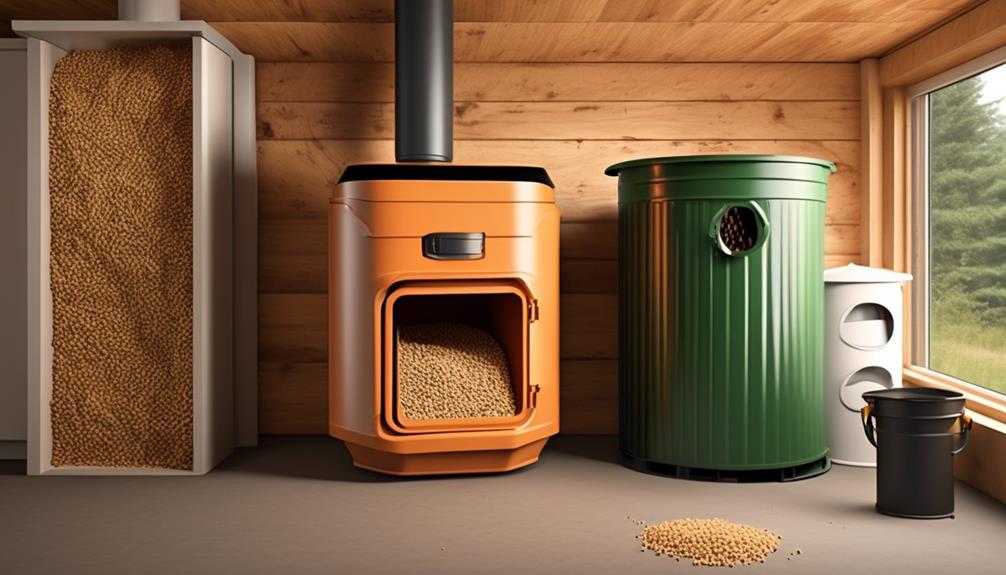
When it comes to pellet storage and handling, understanding the storage space requirements and handling and transportation restrictions is essential.
Properly storing pellets in a dry and ventilated area, using airtight containers to prevent moisture damage, and handling them with care to avoid tearing and spillage are crucial aspects to consider.
Additionally, keeping wood pellets away from direct sunlight and heat sources, as well as regularly inspecting the storage area for pests, are important practices to maintain the quality and integrity of the pellets.
Storage Space Requirements
To ensure proper storage and handling of wood pellets, ample space must be designated in a dry and protected area, allowing for bulk purchases and protection from moisture and pests. When considering storage space requirements for converting a wood stove to pellet, it’s essential to account for the following:
- Ventilation and Accessibility
Proper ventilation is crucial for maintaining pellet quality.
Accessibility to the storage space is necessary for easy handling and refilling.
- Handling Equipment and Tools
Allocate space for handling equipment and tools, such as scoops and containers, within the storage area.
Considering these factors will ensure that the storage space meets the requirements for converting a wood stove to a pellet stove, facilitating efficient pellet storage and handling.
Handling and Transportation Restrictions
Handling and transportation restrictions for pellet storage and handling necessitate careful consideration of weight limits and proper packaging for secure and efficient movement. When converting a wood stove to pellet, it’s crucial to adhere to handling and transportation restrictions to ensure safe and effective operations. Below is a table outlining essential handling and transportation restrictions for pellet storage and handling.
| Consideration | Restriction | Details |
|---|---|---|
| Weight Limits | Maximum weight for individual pellet bags | Ensure each bag adheres to weight restrictions |
| Packaging | Durability and weather-resistance | Use sturdy, weather-resistant packaging materials |
| Storage Space | Maximum stacking height | Adhere to stacking height restrictions for safety |
Adhering to these handling and transportation restrictions is imperative for successful conversion and ongoing safe and efficient pellet usage.
Maintenance and Cleaning

Regularly cleaning the ash from the burn pot and heat exchanger is essential to ensure efficient burning and heat transfer in pellet stoves. When converting a wood stove into a pellet stove, maintenance and cleaning are crucial to optimize performance and longevity. Here are key maintenance tasks to keep your pellet stove running smoothly:
- Basic Cleaning:
- Clear ash from the burn pot and heat exchanger regularly to maintain optimal combustion and heat transfer efficiency.
- Inspect and clean the venting system to prevent blockages and ensure proper exhaust flow.
- Seal and Aesthetic Maintenance:
- Check and clean the gaskets and seals to maintain a tight seal for efficient burning and prevent air leaks.
- Regularly clean the glass window to maintain a clear view of the fire and enhance the stove’s aesthetic appeal.
These maintenance tasks are essential for ensuring the efficient operation of your pellet stove. Additionally, scheduling professional maintenance at least once a year is recommended to ensure all components are functioning optimally and to address any potential issues.
Cost Comparison
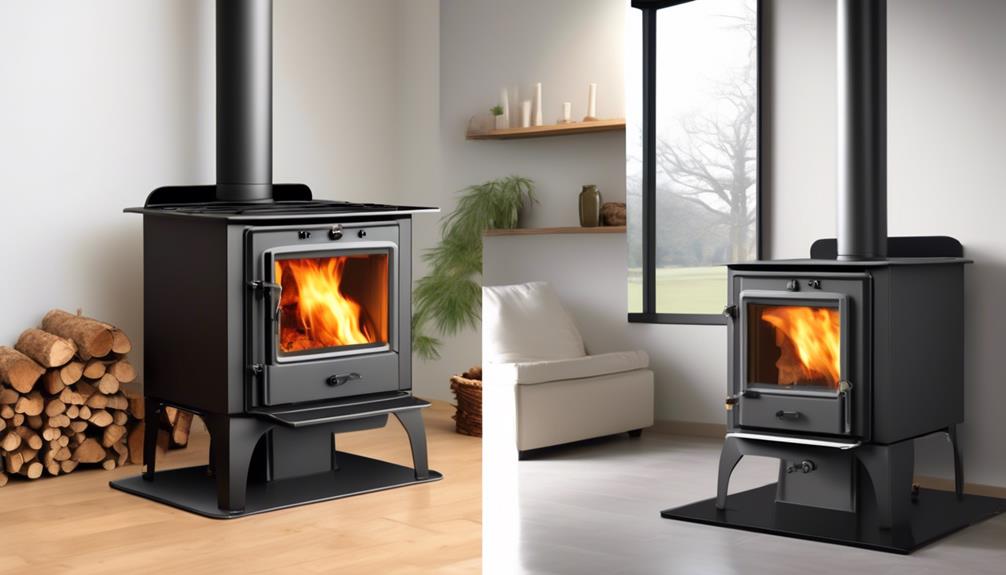
When comparing the costs of converting a wood stove to a pellet stove, it’s important to consider the initial conversion cost, potential long-term savings, ongoing fuel expenses, maintenance and repair costs, and the environmental impact.
The initial conversion cost involves the purchase of the pellet stove and any additional components required for installation. Professional assistance may also be necessary, adding to the initial expense.
Long-term savings should be evaluated by comparing the efficiency of the pellet stove in heating the space and the cost of pellets versus traditional firewood.
Ongoing fuel expenses will be influenced by the price and availability of wood pellets compared to firewood.
Furthermore, maintenance and repair costs differ between wood and pellet stoves, with factors such as cleaning, part replacements, and professional servicing affecting overall expenses.
Additionally, the environmental impact should be considered, as reducing emissions and promoting sustainable practices may result in long-term cost savings.
Heating Efficiency
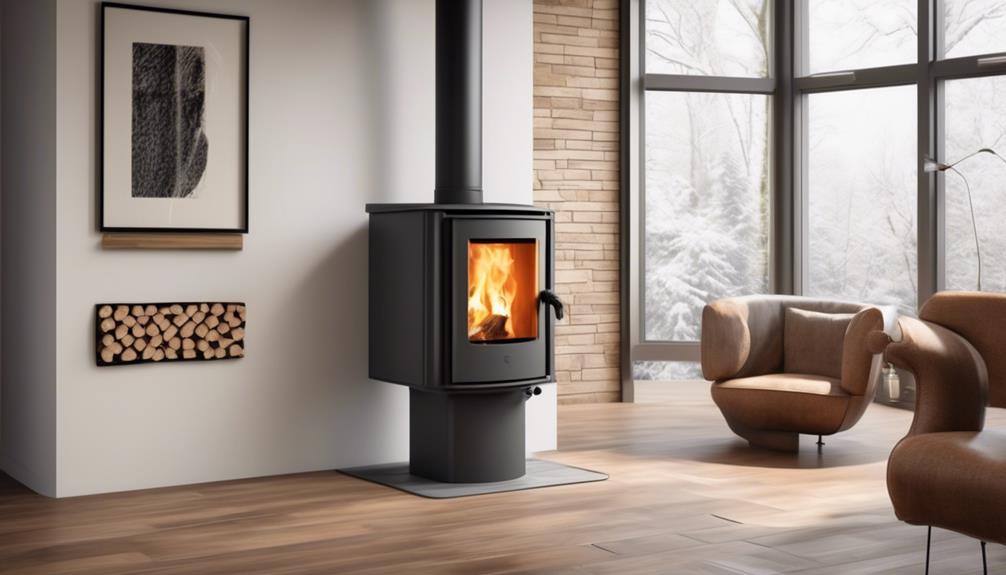
Considering the initial conversion cost and potential long-term savings, it’s important to evaluate the heating efficiency of a pellet stove compared to a wood stove. When comparing the heating efficiency of wood stoves and pellet stoves, there are several key factors to consider:
- Fuel Consistency: Wood stoves rely on logs of varying sizes and moisture content, which can lead to inconsistent burning and heat output. On the other hand, wood pellets are manufactured to a consistent size and moisture level, ensuring more uniform combustion and heat production.
- Heat Output: Wood stoves often require manual adjustment of air intake and frequent refueling to maintain optimal heat output. Conversely, pellet stoves are equipped with automatic fuel feed systems and air regulation, resulting in more consistent and efficient heat generation.
- Emissions: Wood stoves can produce higher levels of particulate matter and emissions compared to pellet stoves, which are designed to burn more cleanly and efficiently, contributing to better air quality.
Safety Considerations
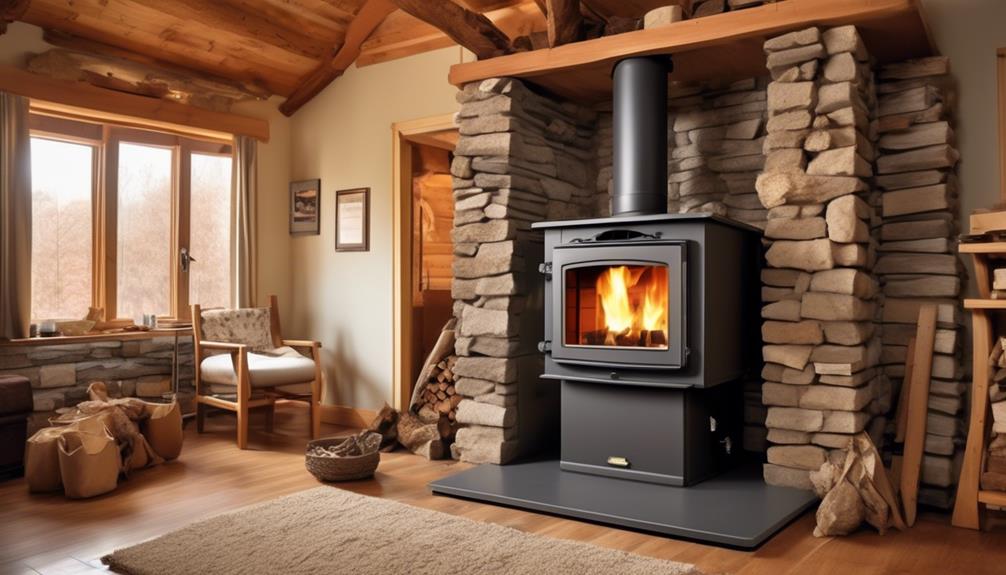
To ensure the safe operation of a converted pellet stove, it’s crucial to follow proper ventilation guidelines and adhere to the manufacturer’s installation instructions to minimize the risk of carbon monoxide build-up.
Proper ventilation is essential for the safe and efficient operation of a pellet stove. It’s imperative to regularly clean the pellet stove and chimney to reduce the risk of chimney fires and to maintain efficient operation.
Using high-quality, approved pellets is also vital to minimize the risk of malfunctions and prolong the life of the pellet stove. Additionally, installing carbon monoxide detectors and fire extinguishers near the pellet stove provides added safety measures.
It’s important to keep children and pets away from the hot surfaces of the pellet stove to prevent burns or other accidents. By following these safety considerations, individuals can enjoy the benefits of converting a wood stove to a pellet stove while ensuring the safety of their home and family.
Incorporating these safety measures is crucial when undertaking the conversion process to ensure a safe and secure heating system.
Pellet Stove Installation
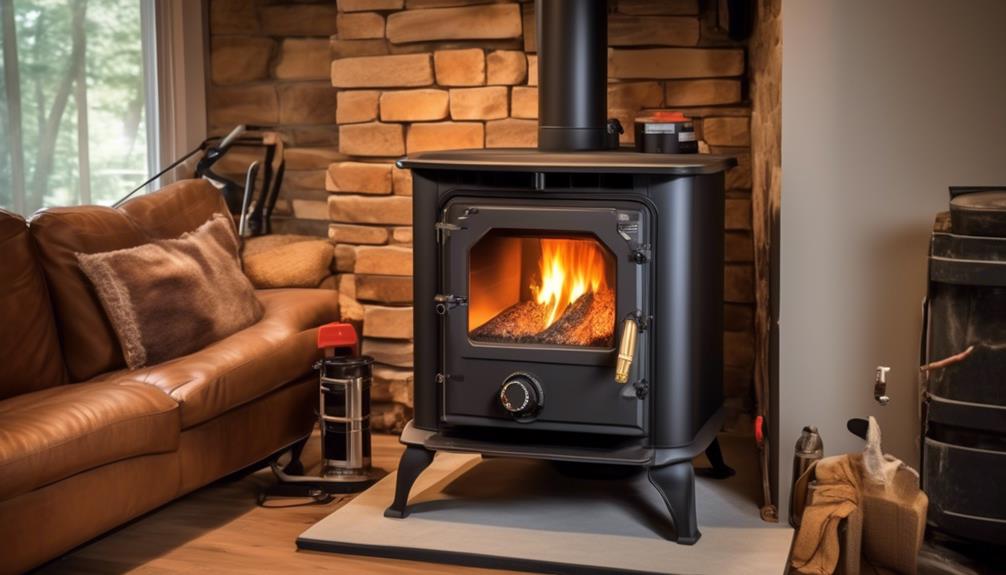
We will first examine the essential steps for installing a pellet stove to ensure a successful and efficient conversion process.
- Prepare the Area
- Clear the space around the wood burning stove, ensuring there are no flammable materials nearby.
- Install a non-combustible hearth pad to protect the floor beneath the pellet stove.
- Install the Pellet Stove
- Position the pellet stove, ensuring it meets the manufacturer’s specified clearances from combustible materials.
- Connect the stove to a venting system that complies with local building codes and manufacturer guidelines.
When installing a pellet stove, precision is key to ensure proper functionality and safety. It’s important to follow the manufacturer’s instructions meticulously to guarantee a seamless conversion from a wood burning stove. By adhering to the guidelines and investing the necessary time and effort into the installation process, the transition to a pellet stove can result in increased efficiency, cost savings, and a reduced environmental impact.
Pellet Stove Operation
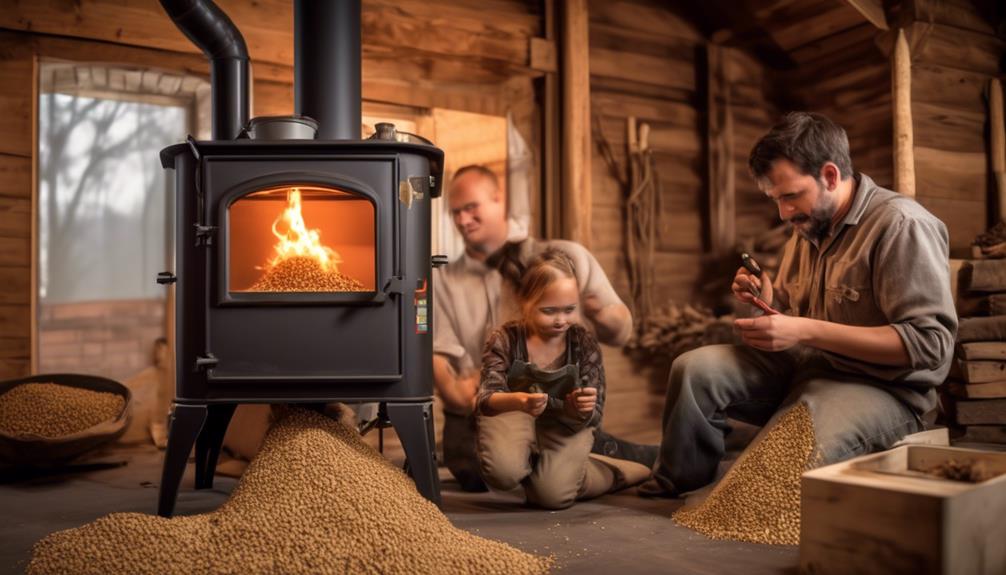
The proper operation of a pellet stove requires regular maintenance and adherence to manufacturer guidelines for optimal performance.
Before initiating the pellet stove operation, it’s crucial to conduct a thorough inspection of the appliance. This includes checking the hopper for any blockages or debris, ensuring that the venting system is clear, and examining the condition of the gaskets and seals.
Additionally, it’s essential to use high-quality pellets that meet the specifications outlined by the manufacturer.
When starting the pellet stove, carefully follow the startup procedure provided in the user manual to prevent any malfunctions.
Throughout operation, it’s important to monitor the stove’s performance, including the combustion process and heat output, to ensure that it’s functioning efficiently.
Regular cleaning of the ash pan, burn pot, and heat exchanger is necessary to maintain the stove’s performance.
Understanding the various settings and controls of the pellet stove is also crucial for optimizing its operation.
Pellet Stove Troubleshooting
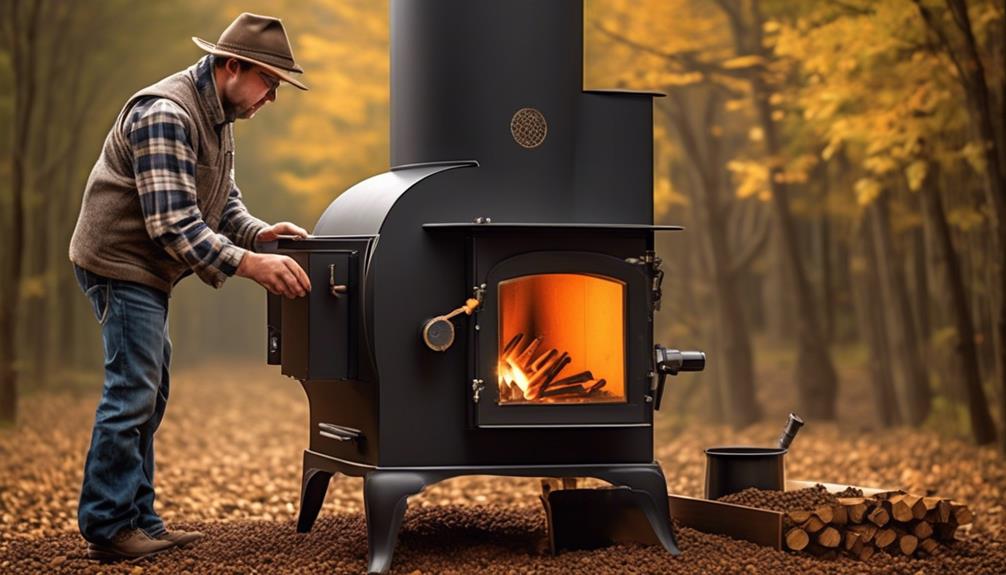
Upon encountering issues with a pellet stove, one should first troubleshoot potential causes to restore optimal functionality.
When troubleshooting a pellet stove, it’s essential to address the following common issues:
- Pellet Stove Ignition:
- Check the power supply and ensure the igniter is clean and properly positioned. This ensures efficient and timely ignition of the pellets, allowing the stove to operate smoothly.
- Poor Pellet Feed:
- Clean the hopper and auger to eliminate any blockages or clogs that may be causing inconsistent pellet feed. This step is crucial in maintaining a steady and reliable fuel supply for the stove.
Additionally, addressing other potential issues such as excessive ash, ignition failures, and inadequate heat output is vital.
Regularly cleaning the ash pan and ensuring the air intake isn’t restricted prevents excessive ash buildup. Inspecting the exhaust vent for blockages and ensuring the door gasket is intact can help prevent issues with ignition.
Checking the thermostat settings and the condition of the heat exchanger ensures optimal heat transfer, addressing any concerns regarding inadequate heat output from the pellet stove.
Frequently Asked Questions
Can a Wood Stove Be Turned Into a Pellet Stove?
Yes, a wood stove can be turned into a pellet stove. It’s a straightforward process that offers improved heating efficiency and cost savings.
By installing a pellet insert like the Energex Prometheus, one can enhance the stove’s performance with better airflow and longer heat provision.
It’s essential to consider factors such as compatibility, professional assistance, and cost comparison when contemplating the conversion.
Conversion kits are available, but it’s crucial to weigh their benefits and challenges against purchasing a new pellet stove.
Can I Put Pellets in My Wood Stove?
Yes, you can put pellets in your wood stove, but it’s essential to ensure that the stove is compatible with burning wood pellets.
Converting a wood stove to burn wood pellets can be a relatively straightforward process, and it’s important to consult with a qualified technician to ensure the safe and efficient use of pellets in your wood stove.
Additionally, investing in a pellet insert can help transform your wood stove into a pellet stove without major modifications.
How Much Does It Cost to Convert a Wood Fireplace to a Pellet Stove?
Converting a wood fireplace to a pellet stove typically costs between $3,000 and $4,000, encompassing installation. The total amount varies according to the complexity of the conversion and any additional materials required. Factors such as labor, chimney modifications, and the specific pellet stove model also influence the overall cost.
Additionally, there may be extra expenses for chimney lining, venting, and electrical work for pellet stoves needing power.
Is It Cheaper to Run a Pellet Stove or Wood Stove?
Running a pellet stove is generally cheaper than a wood stove due to its greater heating efficiency and precise heat output control. This translates to lower fuel consumption and cost savings.
Additionally, pellet stoves are more environmentally friendly and require less maintenance, making them a cost-effective and preferable option over wood stoves in terms of long-term operational expenses.
Conclusion
In conclusion, converting a wood stove to a pellet stove offers numerous benefits.
These benefits include greater heating efficiency, cost savings, and environmental friendliness.
Making the switch to a pellet stove is a relatively simple process, thanks to pellet inserts or conversion kits.
With proper installation and maintenance, you can enjoy all the advantages that a pellet stove has to offer.
So why not make the change and start reaping the rewards today?




